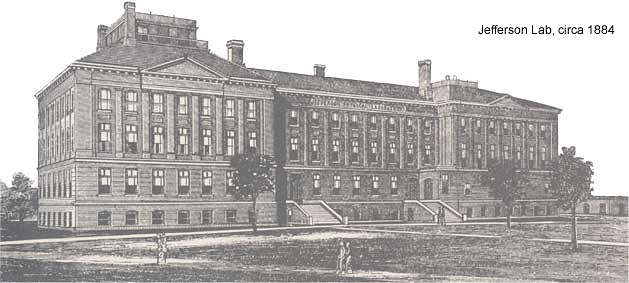 "Do you know about the red bricks and the soul?" asked my guide, out of nowhere. I was visiting the Harvard campus to talk to some physicists, and I was being walked to the department in Jefferson Hall, a gorgeous red-brick building. We'd been engaging in the standard physicist small talk (gossip about other physicists) and had hit a lull, which prompted the question. I said that I hadn't, and I didn't say that that sounded like a very strange thing for a physicist to comment on, souls not generally being something they study.
"Do you know about the red bricks and the soul?" asked my guide, out of nowhere. I was visiting the Harvard campus to talk to some physicists, and I was being walked to the department in Jefferson Hall, a gorgeous red-brick building. We'd been engaging in the standard physicist small talk (gossip about other physicists) and had hit a lull, which prompted the question. I said that I hadn't, and I didn't say that that sounded like a very strange thing for a physicist to comment on, souls not generally being something they study.
The building, I learned, had been built in the late nineteenth century as an advanced, modern facility for the teaching of physics. (Reformers were worried that physics instruction was taught by rote methods, and that students would be better served by hands-on opportunities. Some things never change.) The building was also outfitted with research laboratories, where cutting-edge science could be done.
One young researcher, I was told, had had a spectacular realization about the nature of electricity and magnetism—then recently discovered and wondrous. It was natural, he thought, that the soul was a magnetic phenomenon. After all, magnets worked in very strange ways and new discoveries were constantly being made (the force is perpendicular to the direction of the magnetic field? What?!). The reason the soul seemed so mysterious was that we hadn't had the appropriate technology to detect it.
So, he set up a simple experiment. He outfitted a lab with compasses to detect magnetic fields. And then, well, he would kill animals and see if he could see the soul leaving the body on his instruments. A seemingly elegant idea to detect a previously mysterious phenomenon. There was just one problem: He'd forgotten why bricks are red.
They're red, because they contain iron, and iron is highly magnetic. So the stray magnetic fields from the walls overwhelmed any signal he might have seen from the departing souls.
I should probably mention at this point that I have absolutely no reason to believe that this story is at all true. At least the part about the animals and the souls—and thank goodness. The true story, recounted here, seems to be that they wanted to measure the magnetic field of the Earth, and that the bricks, among other problems, made that impossible.
But the story is fantastic. It simultaneously expresses the mystery of death and the futility of investigating it. It's almost the perfect mad-scientist story—the steampunk setting, trying to learn the secrets of the world beyond with just a magnetometer, the super-creepy science. And then the crushing reality of the real world, and the knowledge that death is almost certainly an unknown, and that animals have needlessly died for a vain quest.
Of course, we do know a lot about death. We know exactly how fast a corpse decomposes in different situations. We know reasonably well what will cause it—from types of stabbings to types of drugs. And from that we can solve crimes and save lives.
We also know that when we encounter it, it's a terrifying thing—the one experiment we can't repeat.
Unless you happen to be Matthew Dicks, a novelist who in this issue recounts his unlikely tale of dying twice before the age of eighteen. Or possibly Bredo Morstoel, a Colorado man preserved on dry ice in a backyard Tuff shed by his hopeful grandson, whose story will be told by writer Emma Komlos-Hrobsky.
But in other stories, the threat of death looms large—whether in the monkey lab, the high school science lab, or one man's heart. Today, we kick things off with a doctor's story of pronouncing a patient dead for the first time.
Ben Lillie is co-founder and director of The Story Collider.
